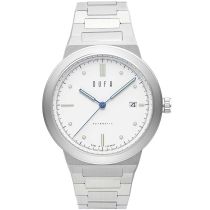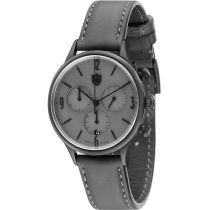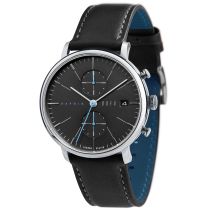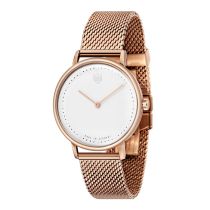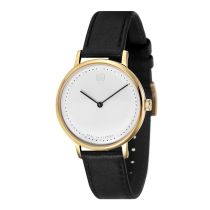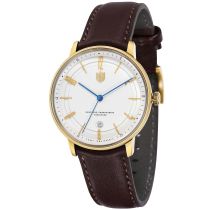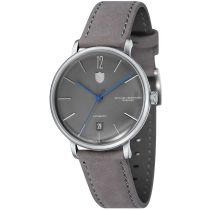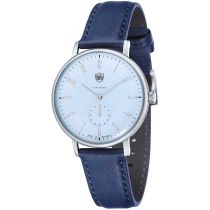
DuFa Watches
DuFa ladies and men's watches - precision mechanics from Germany
THE BRAND DUFA was originally registered in Leipzig by the famous watch factory Etzold & Popitz, which produced its best works before the Second World War. In the midst of the architectural and cultural diversity of the historic federal state of Thuringia, watches with design elements from the discreet neoclassical design, the Bauhaus movement, have been produced for almost a century. Read more about the model family of your DuFa watch
DuFa - A German watch brand is revived
Resurrecting a brand means more than changing ownership and continuing things done in the past. This requires a careful analysis of the traditions, history and past of what has made the brand famous and successful. It also includes a careful consideration of how a brand's values are perceived in the modern world. At DuFa, the new owners have taken this path to pay tribute to the origins of the brand and the most important elements of German precision engineering and manufacturing. Thus, the legendary Bauhaus Design School is built on, with an understanding of other directions that have contributed to shaping the spirit of German culture and design. The aim is to offer a range of watches that illustrate the best traditions of this philosophy, through uncompromisingly modern manufacturing standards and components that are synonymous with the German standard of demanding, subtle excellence.
Following some interesting information about the model families of the brand DuFa and their namesakes:
Ludwig Mies Van der Rohe
LUDWIG MIES VAN DER ROHE is regarded as one of the most influential architects of the 20th century. He was born in Aachen in 1886 and created an influential architectural style of the twentieth century that stands out for its extreme clarity and simplicity. He was the director of the Berlin Bauhaus before moving to America in 1937, where he earned plenty of fame for his enduring masterpieces. Mies, mostly named by his surname, opened himself to modernity and took pleasure in simple, linear and even forms, clear lines, the pure use of colour and the expansion of space. His epochal work defines an age and an era of modernity, clarity and depth, and cerebral reflection in design. Some of his best-known works, such as the Seagram Building in New York, remain timeless in their appeal and are meaningful testimonies to his Bauhaus influence. It is the same essential clarity, simplicity and power in precise minimalism that is the expression of German excellence in DuFa's sophisticated watches.
Hannes Meyer
HANNES MEYER WAS a Swiss architect and theoretician, designer and second director of the Bauhaus in Dessau from 1928 to 1930. In 1919 he was appointed by Walter Gropius as head of the Bauhaus architecture department. Even though he was ultimately a controversial person and politicized his work more than most others, Meyer, like the other avant-gardists of the Bauhaus movement, believed in the transformative value of architecture and design. For him, buildings had to serve a purpose for people and society. Functionalism meant more than wasting money on ornamentation or building more space than was necessary. It meant an efficient structure and a practical construction. It meant materials with properties that brought ecological benefits to the inhabitants. "Environment" is still a new theme for today's architects, but as early as 1930 Hannes Meyer considered thermal and other properties of the materials he used.
Weimar
WEIMAR TAKES A special place in the fabric of German culture. The fascinating paradox of traditional and modern culture provides perfect inspiration for the range of watches in this collection. During the reign of Duke Carl August, the city emerged as the home of the German Enlightenment. The city attracted intellectual and cultural greats such as Johann Wolfgang von Goethe and Friedrich Schiller, who founded a new humanism from the synthesis of ideas from Romanticism and Classicism. Other talents again famous composer Johann Sebastian Bach and the philosopher Friedrich Nietzsche made Weimarzur cultural capital at the time in Europe. In the 20th century the city became known as the birthplace of the Bauhaus movement. While the movements differed considerably in aesthetics, both the Classicist and Modernist periods promoted the experience of human expression and left indelible traces in history.
Josef Albers
JOSEF ALBERS (1888-1976) was an influential artist who helped an entire generation of postwar artists in the United States define and evolve. An accomplished designer, photographer, typographer, and graphic artist, he is best remembered and praised as an abstract painter and theorist about the power of color in design. His studies and theoretical work led to his approach that color should be predominant visual language rather than form. In his groundbreaking series Hommage tothe Square, created from 1949 until his death, Albers uses a single square form to explore the multiple visual effects that can be achieved through color and spatial relationship alone. Alberstrat joined the Weimar Bauhaus in 1920 at the age of 32 and finally became professor or Bauhaus master in Dessau and taught alongside other great Bauhaus figures such as Paul Klee and Wassily Kandinsky.
Marcel Breuer
WALTER GROPIUS taught and supervised Marcel Breuer (1902-1981) was born in Hungary and studied and taught carpentry at the Weimar Bauhaus. However, he quickly established himself as a legendary talent of his own. In 1925 it was Breuer who perhaps designed one of the most iconic pieces of furniture of the 20th century: the steel club chair B3, also known as the "Wassily chair" - this miracle of construction and manufacturing embodies the Bauhaus's goal of trying to bring art and industry into harmony. Breuer continued working with his master and mentor Gropius and moved to Harvard to take up a professorship. He continued to work on the design and development of his architectural works and designed important buildings throughout the world. His furniture, however, demonstrates his true position as the avant-garde of the Bauhaus movement, and he created works that outlast time in concept and design.
Browse through our online watch store and discover the wide range on offer!





 English
English

